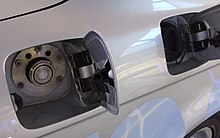
Back Vehicle amb motor de combustió interna d'hidrogen Catalan Vetyauto Finnish 수소내연기관자동차 Korean Veículo com motor de combustão interna a hidrogênio Portuguese Vodíkový pohon Slovak






A hydrogen internal combustion engine vehicle (HICEV) is a type of hydrogen vehicle using an internal combustion engine.[1] Hydrogen internal combustion engine vehicles are different from hydrogen fuel cell vehicles (which utilize hydrogen electrochemically rather than through combustion). Instead, the hydrogen internal combustion engine is simply a modified version of the traditional gasoline-powered internal combustion engine.[2][3] The absence of carbon means that no CO2 is produced, which eliminates the main greenhouse gas emission of a conventional petroleum engine.
As pure hydrogen does not contain carbon, there are no carbon-based pollutants, such as carbon monoxide (CO) or hydrocarbons (HC), nor is there any carbon dioxide (CO2) in the exhaust. As hydrogen combustion occurs in an atmosphere containing nitrogen and oxygen, however, it can produce oxides of nitrogen known as NOx. In this way, the combustion process is much like other high temperature combustion fuels, such as kerosene, gasoline, diesel or natural gas. Therefore, hydrogen combustion engines are not considered zero emission.[citation needed]
- ^ "INL-Hydrogen internal combustion engine vehicles". Archived from the original on 2004-10-15. Retrieved 2008-12-17.
- ^ "Hydrogen Use in Internal Combustion Engines" (PDF). US Department of Energy. December 2001. Retrieved 25 July 2017.
 This article incorporates text from this source, which is in the public domain.
This article incorporates text from this source, which is in the public domain.
- ^ Hydrogen-Fueled Internal Combustion Engines; see section 5